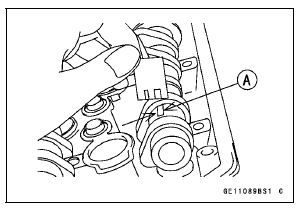

Place a strip on each journal parallel to the camshaft installed in the correct position.

NOTE
Do not turn the camshaft when the plastigage is between the journal and camshaft cap.
Camshaft Journal/Camshaft Cap Clearance Standard: 0.038 ∼ 0.081 mm (0.0015 ∼ 0.0032 in.) Service Limit: 0.17 mm (0.0067 in.)
If any clearance exceeds the service limit, measure the diameter of each camshaft journal with a micrometer.
Camshaft Journal Diameter Standard: 23.940 ∼ 23.962 mm (0.9425 ∼ 0.9434 in.) Service Limit: 23.91 mm (0.9413 in.)
If the camshaft journal diameter is less than the service limit, replace the camshaft with a new one and measure the clearance again.
If the clearance still remains out of the service limit, replace the cylinder head unit.
 Camshaft Installation
Camshaft Installation Camshaft Runout Inspection
Camshaft Runout InspectionBattery Maintenance
It is the owner’s responsibility to keep
the battery fully charged. Failure to do
so can lead to battery failure and leave
you stranded.
If you are riding your vehicle infrequently,
inspect the battery voltage
weekly using a voltmeter. If it drops
below 12.8 volts, the battery should be
...
Gear Position Switch Inspection
NOTE
Be sure the transmission and external shift mechanism
are good condition.
Remove the fuel tank (see Fuel Tank Removal in the Fuel
System (DFI) chapter).
Disconnect the connector [A].
Set the hand tester [A] to the × 1 kΩ or × 100 Ω range
and connect i ...
Clutch Removal
Remove:
Clutch Cover (see Clutch Cover Removal)
Clutch Spring Bolts [A]
Clutch Springs (with Clutch Spring Holders)
Clutch Spring Plate [B]
Pusher [C]
Remove:
Friction Plates (10) [A]
Steel Plates (9) [B]
Spring [C]
Spring Seat [D]
Hold the sub clutch hub [A] ...